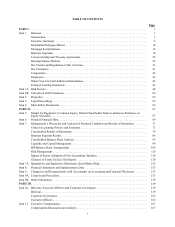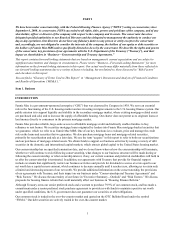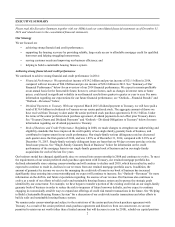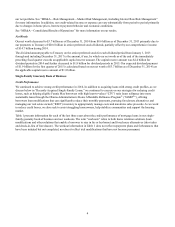Fannie Mae 2014 Annual Report Download - page 12
Download and view the complete annual report
Please find page 12 of the 2014 Fannie Mae annual report below. You can navigate through the pages in the report by either clicking on the pages listed below, or by using the keyword search tool below to find specific information within the annual report.7
(4) The original LTV ratio generally is based on the original unpaid principal balance of the loan divided by the appraised property value
reported to us at the time of acquisition of the loan. Excludes loans for which this information is not readily available.
(5) We purchase loans with original LTV ratios above 80% as part of our mission to serve the primary mortgage market and provide
liquidity to the housing finance system. Except as permitted under HARP, our charter generally requires primary mortgage insurance or
other credit enhancement for loans that we acquire that have an LTV ratio over 80%.
(6) Approximately 79% of the greater than 95% LTV ratio loans we acquired in 2014 were acquired pursuant to HARP. See “Risk
Management—Credit Risk Management—Single-Family Mortgage Credit Risk Management” for information on HARP loans.
As shown in Table 2, our single-family average charged guaranty fee on new acquisitions has increased significantly since
2012, driven by guaranty fee increases implemented in 2012 and increases in loan level price adjustments charged on our
acquisitions, as our acquisitions in 2013 and 2014 included a higher proportion of loans with higher LTV ratios and a higher
proportion of loans with lower FICO credit scores than our 2010, 2011 and 2012 acquisitions. Loan level price adjustments
refer to one-time cash fees that we charge at the time we initially acquire a loan based on the credit characteristics of the loan.
The guaranty fee increases implemented in 2012 included a 10 basis point increase implemented pursuant to the Temporary
Payroll Tax Cut Continuation Act of 2011 (the “TCCA”), the incremental revenue from which must be remitted to Treasury.
See “Our Charter and Regulation of Our Activities—Potential Changes to Our Single-Family Guaranty Fee Pricing” for
information on potential future changes to our guaranty fee pricing.
The increase in our average charged guaranty fee on newly-acquired single-family loans in 2014 as compared with 2013 was
driven primarily by an increase in loan level price adjustments charged on our acquisitions in 2014, as these acquisitions
included a higher proportion of loans with higher LTV ratios and a higher proportion of loans with lower FICO credit scores
than our 2013 acquisitions. The increase in our acquisitions of loans with higher LTV ratios in 2014 as compared with 2013
was primarily due to a decline in the percentage of our acquisitions consisting of refinance loans and a corresponding
increase in the percentage of our acquisitions consisting of home purchase loans, which typically have higher LTV ratios than
non-HARP refinance loans. Despite this shift in the credit risk profile of our acquisitions, the single-family loans we acquired
in 2014 continued to have a strong credit profile, with a weighted average original LTV ratio of 77% and a weighted average
FICO credit score of 744. For more information on the credit risk profile of our single-family conventional loan acquisitions
in 2014, 2013 and 2012, see “Risk Management—Credit Risk Management—Single-Family Mortgage Credit Risk
Management,” including “Table 36: Risk Characteristics of Single-Family Conventional Business Volume and Guaranty
Book of Business.”
Our single-family acquisition volume and single-family Fannie Mae MBS issuances decreased significantly in 2014
compared with 2013; however, liquidations of loans from our single-family guaranty book of business also declined due to
lower refinance activity. Accordingly, the size of our single-family guaranty book of business remained relatively flat.
Whether the loans we acquire in the future will exhibit an overall credit profile and performance similar to our more recent
acquisitions will depend on a number of factors, including our future pricing and eligibility standards and those of mortgage
insurers, the Federal Housing Administration (“FHA”) and the Department of Veterans Affairs (“VA”), the percentage of loan
originations representing refinancings, changes in interest rates, our future objectives and activities in support of those
objectives, including actions we may take to reach additional underserved creditworthy borrowers, government policy,
market and competitive conditions, and the volume and characteristics of HARP loans we acquire in the future. In addition, if
our lender customers retain more of the higher-quality loans they originate, it could negatively affect the credit risk profile of
our new single-family acquisitions.
Providing Targeted Access to Credit Opportunities for Creditworthy Borrowers
Pursuant to FHFA’s 2015 conservatorship scorecard and our statutory mission, we are continuing to work to increase access
to mortgage credit for creditworthy borrowers, consistent with the full extent of our applicable credit requirements and risk
management practices. As part of this effort, we are encouraging lenders to originate loans across the full range of credit
eligibility for those borrowers meeting our credit requirements. Some actions we are taking in this regard include: providing
additional clarity regarding seller and servicer representations and warranties and remedies for poor performance; making
new quality control tools available to lenders; conducting increased outreach to lenders and other industry stakeholders to
increase awareness of our available products and programs; and conducting consumer research to provide industry partners
with information to support their efforts to reach underserved market segments.
In addition, in December 2014, we changed our eligibility requirements to increase our maximum LTV ratio for loans to first-
time home buyers from 95% to 97%. We previously acquired loans with LTV ratios up to 97% from all lenders, but in late
2013, we changed our eligibility requirements to reduce our maximum LTV ratio to 95% for non-HARP acquisitions from
lenders other than housing finance agencies, effective for acquisitions beginning in July 2014. Although higher LTV ratio
loans typically present a higher credit risk than lower LTV ratio loans, we believe our acquisition of single-family loans with
























